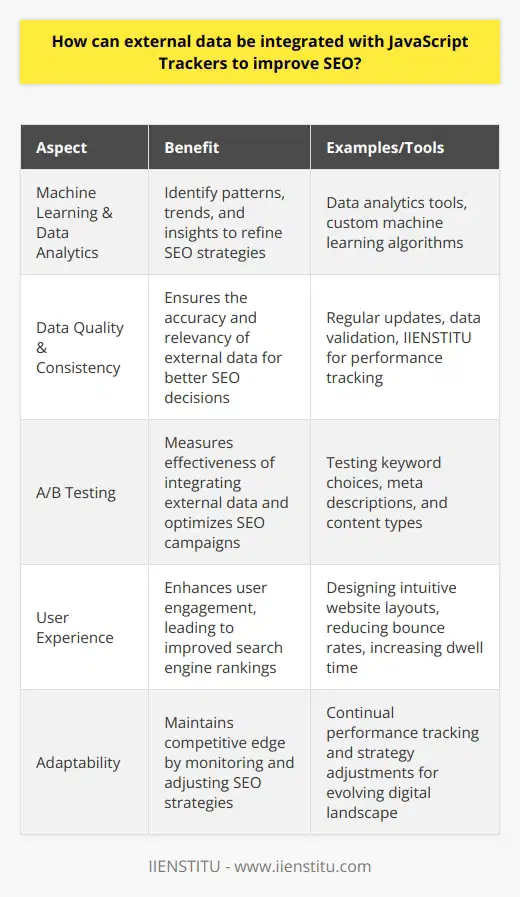This article provides an overview of how JavaScript trackers work, their benefits, and how to integrate external data sources to gain a more comprehensive view of visitor behavior.
JavaScript trackers allow website owners to identify and weed out crawlers and bots and gain a better understanding of user activity across multiple devices and sessions. In addition, integrating external data sources into JavaScript trackers can provide website owners with an even more detailed view of visitor behavior. However, it is essential to be aware of privacy and security considerations.
Introduction
How JavaScript Trackers Work
Integrating External Data
Conclusion
Introduction: Using JavaScript trackers is valuable for SEO professionals, offering more detailed insights into website visitor activity than traditional web server log stats. JavaScript trackers provide a comprehensive view of visitor behavior, allowing website owners to accurately differentiate between real visitors and bots and gain a better understanding of user activity across multiple devices and sessions. This article will provide an overview of how JavaScript trackers work, their benefits, and how to integrate external data for even more detailed insights.
How JavaScript Trackers Work
JavaScript trackers monitor user behavior on a website, tracking mouse movements, clicks, and other user interactions. This allows website owners to identify and weed out crawlers and bots that may be using false user strings. JavaScript trackers can also collect in-depth visitor information, such as the visitor’s IP address, browser type, operating system, etc. This information can be used to understand user behavior better, allowing website owners to make informed decisions about content optimization and website design.
The main limitation of JavaScript trackers is that they are limited to tracking activity on the website itself. They cannot track user activity on other websites or across multiple devices and sessions. However, this limitation can be overcome by integrating external data sources, such as social media activity and third-party analytics, to gain an even more detailed view of visitor behavior.
Integrating External Data
Integrating external data sources into JavaScript trackers can give website owners a more comprehensive view of visitor behavior. For example, combining social media data can provide insights into how visitors interact with the website on social media platforms. In addition, integrating third-party analytics can provide insights into user behavior across multiple devices and sessions.
When integrating external data sources, it is essential to be aware of privacy and security considerations. In addition, it is vital to ensure that any data collected is used responsibly and securely and that visitors know how their data is used.
Conclusion: JavaScript trackers are a valuable asset for SEO professionals, providing an in-depth view of website visitor behavior that is unavailable from traditional web server log stats. They can be used to differentiate between real visitors and bots and gain a better understanding of user activity across multiple devices and sessions. In addition, external data sources can be integrated into JavaScript trackers to provide an even more comprehensive view of visitor behavior. However, it is essential to be aware of privacy and security considerations.
Uncovering SEO with JavaScript Trackers is like finding a needle in a haystack.

Frequently Asked Questions
What are the benefits of using JavaScript Trackers for SEO?
Search Engine Optimization (SEO) is crucial to any website's success. Proper SEO optimization is required to maximize a website's visibility and to rank on search engine results pages (SERPs). One of the tools used for SEO optimization is JavaScript trackers, which can provide various benefits for web admins.
JavaScript trackers, also known as JavaScript SEO trackers, are snippets of code placed on a web page to track and monitor the page's performance. They are used to measure the effectiveness of SEO efforts and to compare the performance of different web pages. Additionally, they can help to identify trends in user behavior and provide insight into how visitors are interacting with the website.
One of the primary benefits of using JavaScript trackers for SEO is that they can provide detailed, real-time analytics. This allows web admins to track the performance of their website in terms of SERP rankings, website traffic, and other essential metrics. This data can be used to identify areas for improvement and to optimize the website for better search engine rankings.
Another benefit of using JavaScript trackers for SEO is that they can help identify and eliminate technical issues hindering the website's performance. By tracking the performance of a web page, web admins can identify and address any underlying technical issues that might be impacting the website's ranking on SERPs. Additionally, they can identify any content or code that might slow down the website's loading speed and make the necessary changes to improve its performance.
Finally, JavaScript trackers can be used to track a website's performance across multiple devices. This allows web admins to identify any issues that might impact the website's performance on specific devices and make the necessary changes to ensure that the website performs optimally on all devices.
In conclusion, JavaScript trackers can provide several benefits for web admins when optimizing their websites for SEO. By providing detailed, real-time analytics, JavaScript trackers can help web admins identify and address technical issues impacting the website's performance and optimize the website for better search engine rankings. Additionally, they can track the website's performance on multiple devices, ensuring it performs optimally on all devices.

How can external data be integrated with JavaScript Trackers to improve SEO?
Integrating external data with JavaScript trackers is a great way to improve SEO performance. This article will explore how shallow data can create more effective SEO campaigns.
The first step in effective SEO is to understand the data available to you. This includes understanding which external data sources are available and how they can be used to improve SEO. External data sources include social media, search engines, and other digital sources. You can create a more targeted SEO strategy by understanding the available data.
Once you have identified external data sources, you can integrate them into your JavaScript trackers. JavaScript trackers can be used to track user behavior, such as clicks and page visits, and user engagement, such as time spent on a page, page views, and other metrics. By integrating external data into your JavaScript trackers, you can better understand user behavior. This can help you identify trends and optimize your SEO campaigns accordingly.
Another way to integrate external data into your JavaScript trackers is to use APIs. APIs allow you to access external data quickly and easily. This enables you to create a more comprehensive view of user behavior and engagement. For example, you can use an API to access data from social media platforms, such as Facebook, Twitter, and Instagram. This data can then be used to understand user engagement better and optimize your SEO campaigns.
Finally, you can use external data to create more targeted SEO campaigns. By understanding user behavior and engagement, you can make more targeted campaigns that are more likely to convert. For example, you can use external data to identify the content and topics most likely to engage your target audience. This can help you to create more compelling content that is more likely to rank higher in search engine results.
In conclusion, integrating external data with JavaScript trackers can be a great way to improve SEO performance. By understanding the data available, incorporating it into your trackers, and using it to create more targeted campaigns, you can make more effective SEO campaigns.

What are the limitations of using JavaScript Trackers for SEO?
Search Engine Optimization (SEO) is a critical factor in driving organic critical traffic and improving website ranking. Therefore, businesses need to optimize their websites for search engines to stay competitive in their respective industries. However, in recent years, SEO has become increasingly complex due to the emergence of search engine algorithms that continually change and evolve. As a result, SEO professionals have had to adjust their strategies to keep up with these changes. One of the most popular tools to track SEO performance is JavaScript Trackers.
While JavaScript Trackers are great for tracking SEO, they have several limitations. First, the data collected by JavaScript Trackers is limited to pages already indexed by search engines. This means the trackers can only provide information about pages already listed in the search engine results. As a result, they cannot provide insight into how a website performs concerning unindexed pages or pages not yet listed in the search engine results.
Second, JavaScript Trackers can only provide metrics such as page views and time spent on age, which are not necessarily indicative of SEO performance. This is because the metrics do not consider factors such as the quality of the content, the relevance of the keywords used, the internal linking of the pages, and the website's overall user experience.
Finally, JavaScript Trackers cannot provide insight into how search engine algorithms determine rankings. As a result, it can be challenging to decide which keywords, phrases, and strategies are helping improve website rankings. This means that it can be difficult to adjust SEO strategies based on the data provided by the trackers.
In conclusion, while JavaScript Trackers can provide valuable insights into SEO performance, they have several limitations. Therefore, for businesses to get the most out of their SEO strategies, it is essential to understand the rules of JavaScript Trackers and supplement them with other systems and tools.



